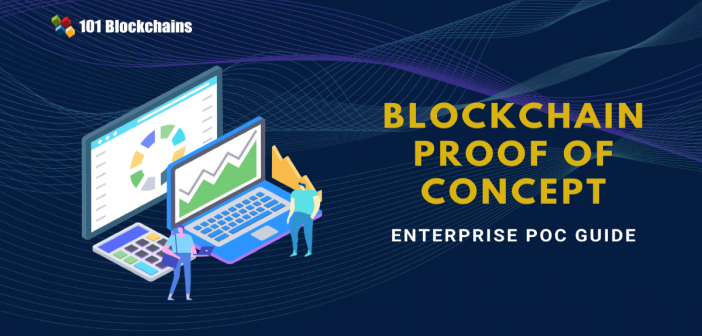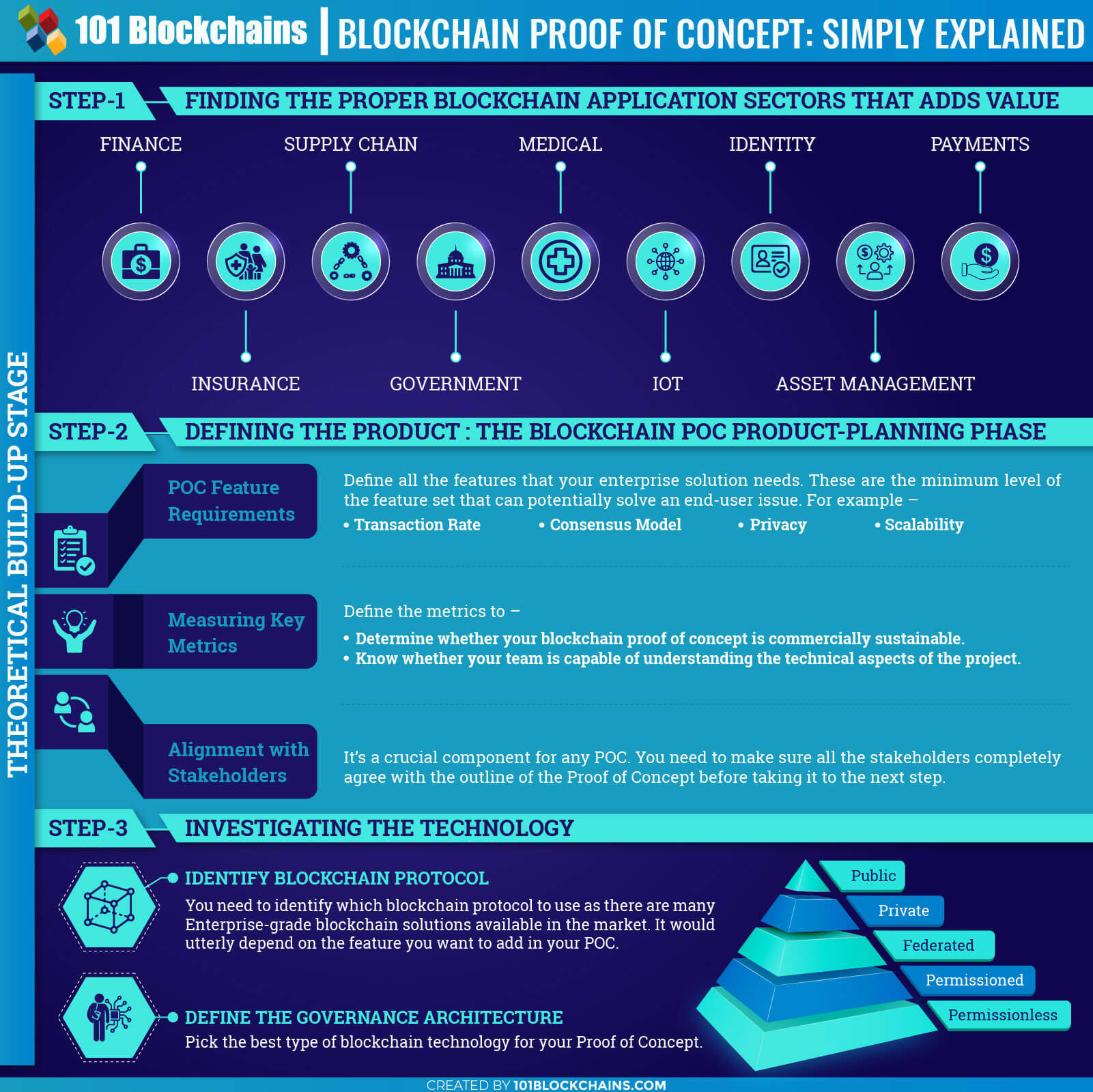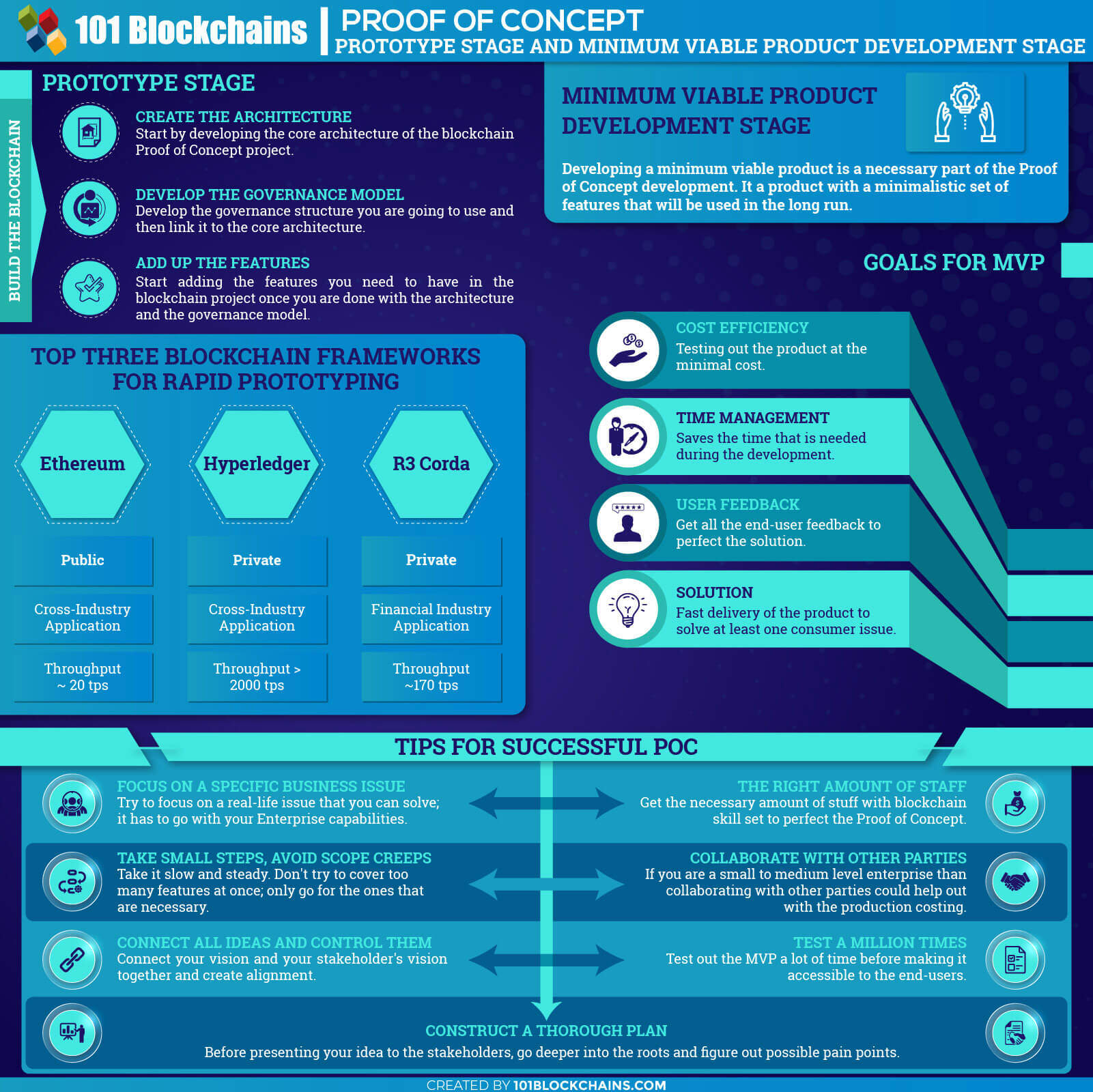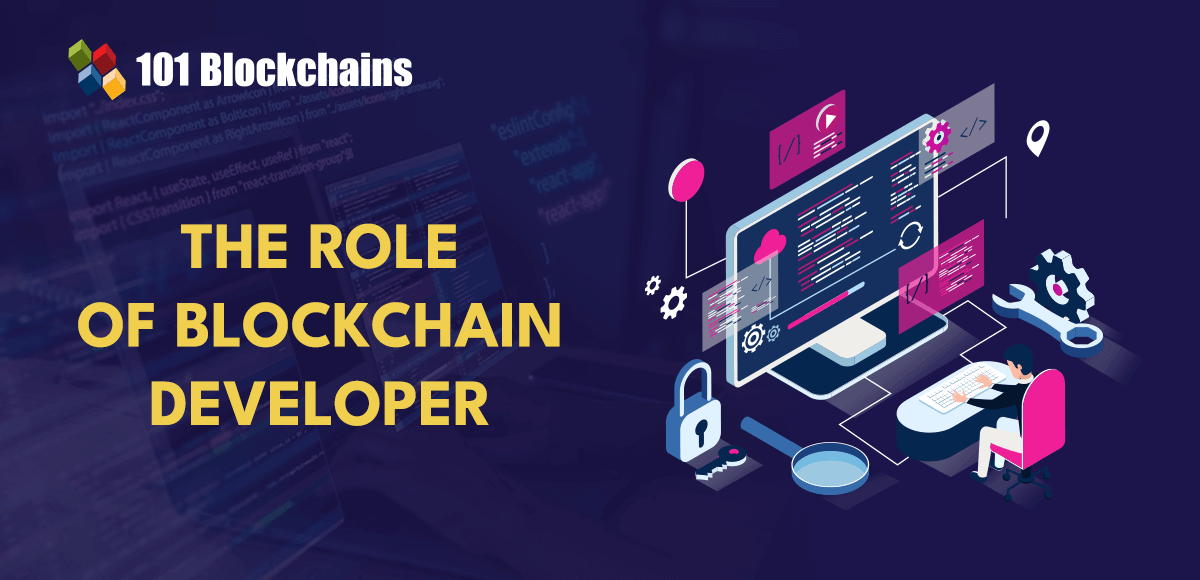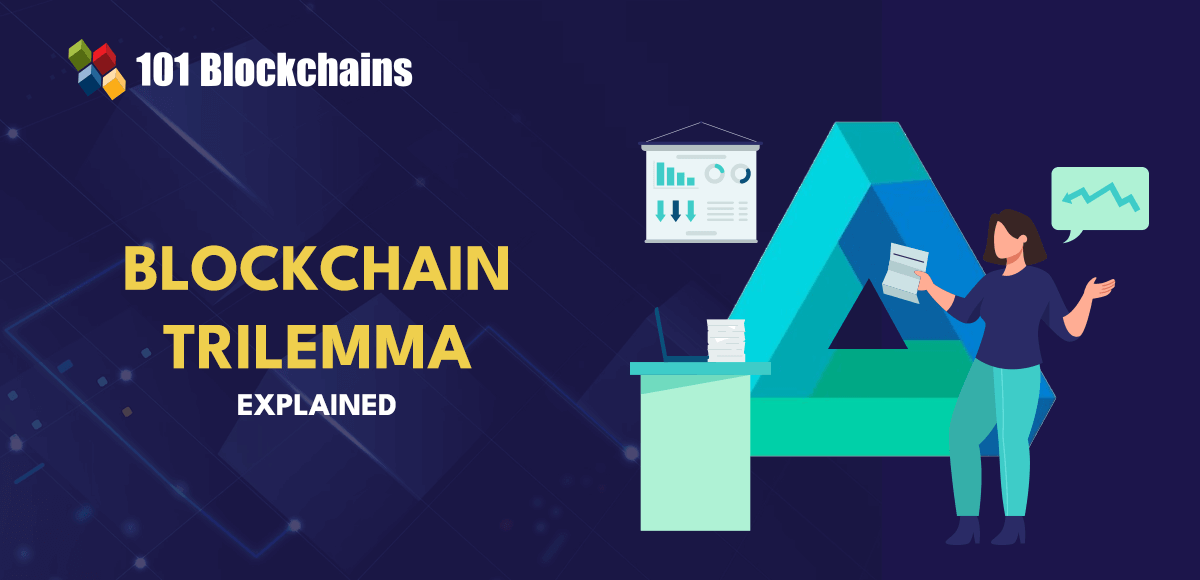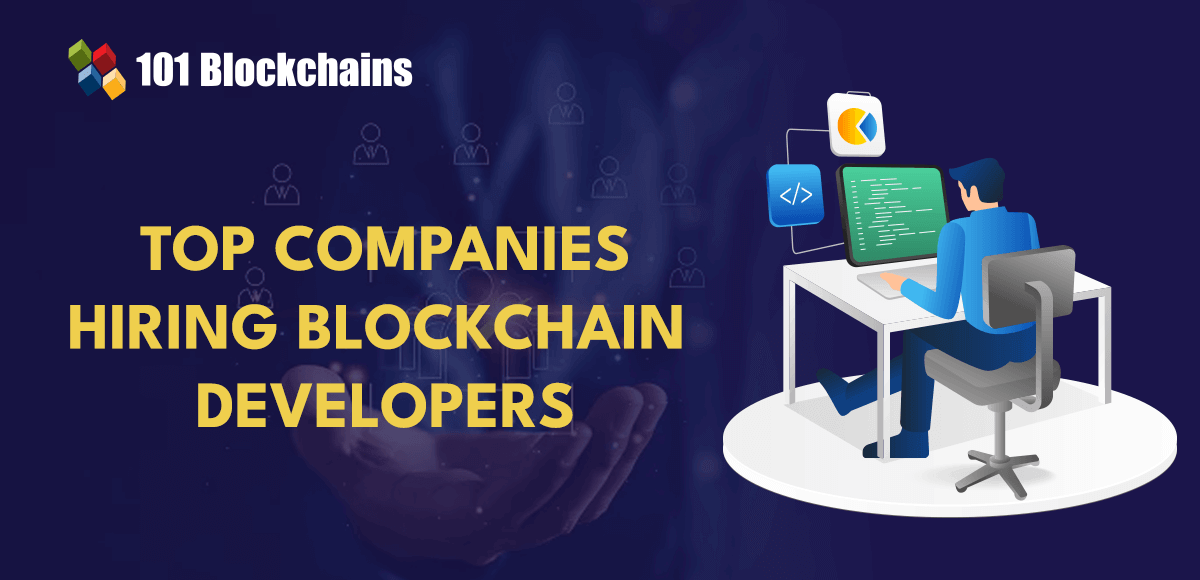This article offers a comprehensive view on blockchain Proof of Concept (POC) — the starting point for any enterprise blockchain development. Also, you’ll get to learn about blockchain POC framework, development, different stages, and construction verdict.
With blockchain innovations on the rise, the chances are that you also believe in the technology and think that it will disrupt your industry as well. Well, don’t worry you are not alone in this. There are many CIOs or enterprise leader that think exactly like you and want to make a difference starting now.
However, many of them know about the benefits but don’t really know how to start your blockchain experimentation. Moreover, they don’t probably have an unlimited budget for long experimentation that doesn’t come out as they hoped it would.
If you are among them, then you have come to the right place. Today, we’ll be showing you the stages of blockchain proof of concept and how to develop a successful plan.
Therefore, you’ll know answers to some common questions — what is proof of concept blockchain? — and — proof of concept blockchain meaning.
Build your identity as a certified blockchain expert with 101 Blockchains’ Blockchain Certifications designed to provide enhanced career prospects.
What Is Proof of Concept Blockchain?
The Blockchain Proof of Concept is a process of determining whether a Blockchain project idea can be feasible in a real-world situation — a common type of consensus algorithm for blockchain. This process is necessary to verify that the idea will function as envisioned.
The best part about proof of concept blockchain meaning is that it will help you to get a clear idea of what you are doing before you even get started. Furthermore, the proof of concept in the blockchain niche isn’t for exploring the marketplace for ideas only. Moreover, you won’t determine the best way to start the production process.
Instead, you’ll only work on your possible blockchain solution option and see whether it’s capable of being a reality or not.
Developing a blockchain proof of concept would require an investment of time, money and resources. In reality, you’d need to get your hands-on supporting technologies or even the physical components needed to get the perfect plan.
Going through the process is necessary for enterprises to see whether their idea is visible before using all production-level equipment for it.
According to a recent Gartner survey, 66% of CIOs think that blockchain is here to disrupt the existing marketplaces. And many will spend more than $10 million on the experimentation of the technology.
Why Do Enterprises Need a Proof of Concept?
Usually, the blockchain proof of concept is awfully popular among the startups in the market. However, proof of concept in blockchain can also be a great tool for Enterprises as well. Mainly there are three points for needing it –
- Test out the blockchain project before going for mass production.
- Identify possible pain points that can make the project not useful.
- Save an enormous amount of time and money.
Although anyone who comes up with a blockchain project idea will think that it will work, however, proof of concept in blockchain will test out your idea to ensure that you get the best version out of it, which will save up a lot of time and money in the process.
Another major reason for you to use proof of concept for blockchain is to ensure that all the stakeholders love your idea and would be interested in investing in it. Whether you are just adding up a new type of feature in the existing blockchain solution or developing it from scratch blockchain proof of concept would let you take the fastest route possible. This relatively gives a different edge in the proof of concept blockchain meaning.
Curious to learn about blockchain implementation and strategies? Enroll Now in Blockchain Technology – Implementation And Strategy Course!
Blockchain Proof of Concept Stages
Please include attribution to 101blockchains.com with this graphic. <a href='https://101blockchains.com/blockchain-infographics/'> <img src='https://101blockchains.com/wp-content/uploads/2019/04/Blockchain-Proof-Of-Concept-POC.jpg' alt='Blockchain Proof Of Concept='0' /> </a>
Theoretical Build-Up Stage
This is the stage where you will come with the theoretical aspect of the blockchain POC framework. If you don’t have a proper plan of what you need or where you need it, it won’t really be a proper blockchain development. So, let’s see what the steps of this stage are.
Step-1: Finding the Proper Blockchain Application Sectors That Adds Value
Let’s start with the first step of the theoretical build-up stage. Many of you don’t really know which application sectors are great for blockchain Proof of concept. That’s why we are outlining some major application sector where you can use your solution. These are –
Finance
Let’s start with the trade finance blockchain sector. This sector is relatively popular among the blockchain community. Furthermore, there are many projects already that cover this sector and offer a lucrative solution for major issues. So, in that sense, this sector is quite competitive in case of blockchain POC development.
Banks or other finance companies are already working with blockchain. In reality, if you are a financial enterprise then going for finance sector is your best bet. Also, you’ll be covering what you are experienced at, so risk factors will be much less. You can use blockchain proof of concept in these use cases –
- Trading
- Peer-to-peer lending
- Settlements
- Equities
- Prediction markets
- Anti-money laundering
- Collateral management
- Know your client (KYC)
- Trade reporting & risk visualizations
- Crowd Funding
Enroll Now: Enterprise Blockchains and Trade Finance Course
Healthcare
The medical sector is another major blockchain application sector at present. There are countless scenarios where blockchain can truly shine. Hospitals have to deal with a lot of falsifying reports and counterfeit drugs.
Moreover, there are many cases where doctors falsify their medical certificate and carry on treating patients. Blockchain POC framework can tell you whether your blockchain solution can solve these issues. Moreover, help maintain the patient’s privacy with disclosing medical records. In an early stage of blockchain POC development, you need to make sure that your implementation offer full security in the blockchain for healthcare sector. You can use blockchain proof of concept in these use cases –
- Records sharing
- DNA sequencing
- Personalized medicine
- Compliance
- Prescription sharing
Asset Management
Maintaining asset in these times are relatively hard due to all the bad players in the market. Simple paper-based record keeping isn’t enough now. Moreover, due to political and other reasons, ownership management is at risk of becoming a corrupted sector.
For example, many people take land ownership, but due to keeping paper-based trails, bad players change parameter which ultimately results in losing the property. Furthermore, banks also need to keep track of whether a customer is capable of paying up home mortgages or not.
Blockchain POC development can easily solve these issues you add proper security and verification protocols in the blockchain proof of concept project. Furthermore, you can use blockchain proof of concept in these use cases –
- Digital asset records
- Land title ownership
- Home Mortgages & payments
- Car leasing & sales
Read More: Asset Tokenization on the Blockchain – A Complete Guide
Government
Many governmental institutions are falling behind in the race of digitization. Moreover, every citizen needs a better infrastructure which will give them the security they need. In reality, the government sector is unable to reserve the citizen rights properly.
That’s why the growth of this economy is falling behind leading to massive governmental burdens. What you can do here is to offer a secured network system that would allow the government to go paperless.
Furthermore, if your blockchain POC development can offer governance grade security without any issues, it would definitely be a huge success. But it’s best for governmental enterprises to go for this blockchain for government sector because they have proper knowledge regarding how the government works.
Furthermore, you can use blockchain proof of concept in these use cases –
- Voting
- Copyrights
- WIC, Vet, SS, benefits, distribution
- Licensing & identification
- Vehicle registration
- Citizen identification
Identity
Identity management is a big hassle when it comes to enterprises. Furthermore, many often impersonate other people’s identity and commit serious crimes. Even in trade financer, many companies have to deal with fake companies and fake documents.
Moreover, with digital identity management, you can also track products or even offer multifactor authentication process for extremely sensitive information. However, the identity sector is a sensitive sector that relies mostly on security and privacy.
So, your blockchain POC development needs to have strong security protocols.
You can use blockchain proof of concept in these use cases –
- Digital identity
- Digital assets
- Purchase & review tracking
- Product tracking identity
- Education & badging
- Refugee tracking
- Multifactor authentication
IoT
Internet of things is a wonderful sector for proof of concept in blockchain development. Furthermore, this sector is responsible for linking all your smart applications together. Moreover, the device-to-device connection in a secured platform is necessary.
As multiple devices are connected in one place here, a security breach in even one of the devices would result in a massive invasion of privacy. In reality, you can use this sector in your blockchain proof of concept project. It’s a relatively newer addition; the competition isn’t that huge. Also, blockchain and IoT really solves one of the most major issues in the digital world.
Furthermore, you can use blockchain proof of concept in these use cases –
- Cross-company maintenance markets
- Smart home & office management
- Grid monitoring
- Device directories
- Device to Device payments
Payments
The payments sector is another awesome application point for your enterprise-grade solution. The blockchain system is more than capable of handling payments, and many of it also offer micropayments. Furthermore, it takes a really small amount of time to send money compared to the traditional banking system. Not to mention the reduction of fees in overseas payment.
Moreover, the traditional payment system is due for upgradation and with your unique blockchain proof of concept solution you can easily change the marketplace. No wonder blockchain in payment is getting more and more traction over the years.
You can use blockchain proof of concept in these use cases –
- Rethinking wallets & banks
- Tax filing & collection
- B2B international remittance
- Micropayments
Supply Chain
Big enterprise needs to have their eyes and ears in every step of the supply chain process. Furthermore, any minor errors could end up in a million dollars of loss. Obviously, you would not want that. Tracking where the raw materials are coming from and whether your products are truly authentic or not is one of the major pain points.
In reality, blockchain for supply chain has a lot of scopes for you to integrate proof of concept here. And so, it’s one of the biggest application points for you.
You can use blockchain proof of concept in these use cases –
- Shipping & logistics management
- Agricultural food authentication
- Pharmaceutical tracking & purity
- Real-time auction for supply delivery
- Dynamic agriculture commodities management
Enroll Now: Enterprise Blockchains and Supply Chain Management Course
Insurance
The insurance industry is facing some serious problems regarding insurance claims and document authentication. Also, the enormous amount of paperwork that every single employee has to fill out is overly dreadful.
Detecting fraud, managing all the documents in a secure environment is tough. So, if you introduce a blockchain framework that can solve all these issues would be a huge factor.
However, the competition in blockchain for insurance is a bit high; still, with proper blockchain proof of concept, it should be a great opportunity.
You can use blockchain proof of concept in these use cases –
- Claim filings
- Self-administered insurance
- Automated underwriting
- Asset management
- Digital authentication
- Fraud detection/prediction
- Claims processing & admin
- Property payments
Step-2: Defining the Product
In the second stage of the theoretical build-up, you would need to think your blockchain Proof of concept just like any other product. Furthermore, you need to have a solid plan along with full support from all stakeholders.
But how do you come up with the solid plan? Well, for that you need a product planning phase or workshop.
The Blockchain POC Product-Planning Phase
In your product-planning phase, you would have to call a meeting with all the stakeholders. Moreover, it could be one day or two-day meeting based on your needs. Therefore, you will conduct some series of exercises to pan down your blockchain proof of concept idea down to the core value.
This way you will be able to come up with a workable roadmap. Here you would have to decide on three main components –
- POC Feature Requirements
- Measuring Key Metrics
- Alignment with Stakeholder
POC Feature Requirements
Define all the features that your enterprise blockchain solution needs. After deciding your blockchain application, you would probably have some idea on what features to add up. However, other team members would help you out with that. These are the minimum level of the feature set that can potentially solve an end-user issue. For example –
-
Transaction Rate
The transaction rate fully depends on which sector you’ll be using it in. If you are an enterprise that has to deal with a lot of money transactions every day like a bank, then you would need high transaction rates.
Furthermore, going for a thousand transactions every second would be the safest bet. However, you would also need to make sure that the network would be capable of handling the large transaction rate and won’t slow down.
On the other hand, if you are SMBs that don’t need too many transactions every day then settling for less would be wise. You won’t need an unnecessary number of features when in reality you don’t even need it.
-
Consensus Model
Another major feature that you need to look out for is the consensus model. Why? Well, because without any kind of consensus how will your blockchain solution even be blockchain, right? Furthermore, there always needs to be a solid way to reach an agreement between the users without favoritism.
There are many consensus protocols out there. However, every single one of them comes with its set of pros and cons. So, according to your idea you need to balance out which consensus protocol, would be suited for your blockchain proof of concept.
-
Privacy
Privacy is a major issue. If you are an enterprise that doesn’t want to make everything open for everyone to see, then you would have to add up privacy options. Using authentication process would highly work in this matter.
Furthermore, if you are dealing with identification or storing sensitive information, then privacy is a major concern. Not every user should be able to see other’s sensitive information. Due to the decentralized nature none can find out where blockchain is stored exactly!
-
Scalability
Your blockchain network has to be scalable. It’s one of the major flaws of blockchain technology. That’s why when too many users start to use the network it becomes utterly slow losing it’s faster output.
But if you want to shine with your blockchain Proof of concept, you need to add scalability among the features. Once you understand the user problem, adding the features that solve the issue won’t be a difficult task.
Measuring Key Metrics
After that, you would need to discuss the metrics and define it. Furthermore, you need to focus on OMTM or one metric that matters because for two major reasons –
- These metrics will guide the development team during the prototyping phase of blockchain proof of concept. Furthermore, every single effort needs to have a direct relationship with these metrics.
- You would need to define how you will get your returns in case of a successful blockchain proof of concept. Because it’s an investment too and you need to see how it will benefit you.
As it’s a proof of concept, these metrics would need to include –
- Determination of whether the blockchain Proof of Concept can be commercially viable. Because once the Proof of concept blockchain project is complete, you would need to make the call whether you want it to go in production level or not. Furthermore, you would also need to measure the possible returns if you take it to the production level.
- You need to know whether your team has a technical understanding of blockchain. Even if you decide that your company isn’t suitable for deploying the blockchain project yet, you need to get experience in working with it. This way when your enterprise is finally ready to launch the blockchain project, you can do it rather quickly.
Enroll Now: Enterprise Blockchains Fundamentals Course
Alignment with Stakeholders
It’s a crucial component for any POC. You need to make sure all the stakeholders completely agree with the outline of the Proof of Concept before taking it to the next step. Why?
Well, basically stakeholders will have a greater influence on your enterprise company. So, while you are stating your idea or fixing the features you want to add, you need to ask for their option as well. Furthermore, instead of only letting them know about your idea, you would want to include them as well.
Take as much time you need to come to an agreement because you will be investing your time and resources in the Blockchain Proof of concept. So, it’s best to stay on the safer side in case of any bad outputs.
Step-3: Investigating the Technology
After you’ve come up with the solid idea of what features to include and how to focus the roadmap, you would need to hand them off to the engineering team. Therefore, your team will then research the technology based on your requirements and come up with the best platform to develop it on. There are two steps here –
-
Identify Blockchain Protocol
You need to identify which blockchain protocol to use as there are many Enterprise-grade blockchain solutions available in the market. It would utterly depend on the feature you want to add in your POC.
Furthermore, you would also need to look into the performance of each platform and pick the one closest for your blockchain proof of concept. However, your technical team will handle this part mostly. Moreover, you would need to set up meetings to see which platforms they picked and how they will approach the situation.
Read More: Top 5 Enterprise Blockchain Protocols
-
Define the Governance Architecture
Governance architecture is the second crucial factor of blockchain proof of concept. That’s why you need to pick the best type of blockchain technology for your Proof of Concept blockchain project. A fundamental question is whether or not your network should be private or public.
It’s quite common for enterprises or SMBs to go with private networks. However, it might not always be the case.
Enroll Now: Certified Enterprise Blockchain Architect (CEBA)
There are practically five kinds of government architecture you can go for –
Public
Why Use This?
- User empowerment
- Immutability
- Truly decentralized structure
- Greater transparency
- Offers anonymity
Private
Why Use This?
- Preserves privacy
- Faster output
- Doesn’t offer anonymity
- Power efficient
- Less volatile network
- Organizational empowerment
Federated
Why Use This?
- Saves a lot of costs
- Energy efficient
- Offers lower transaction fees
- Highly scalable
- Network regulations
- Extremely faster output
- No criminal access
- Distributed authority
Permissioned
Why Use This?
- Suited for organizations
- Relatively faster
- Transaction rates are low
- Trusted environment
- Isn’t required to have a native asset
- Variable decentralization
Permissionless
Why Use This?
- More power for the nodes
- Trust-free environment
- Open privacy level
- Usually decentralized
- Free participation in voting or consensus
Please include attribution to 101blockchains.com with this graphic. <a href='https://101blockchains.com/blockchain-infographics/'> <img src='https://101blockchains.com/wp-content/uploads/2019/04/blockchain-poc.jpg' alt='Blockchain Proof of Concept='0' /> </a>
Prototype Stage
This is the second stage of the blockchain Proof of concept. Here, you’ll be building the prototype for your blockchain deployment. Furthermore, in this stage, your stakeholders and your technical team should already be aligned with the structure of the deployment.
Build the Blockchain
Building the blockchain would include creating the architecture, governance model and adding up the feature.
-
Create the Architecture
Start by developing the core architecture of the blockchain Proof of Concept project. Therefore, your technical team would start by creating the genesis block as the ancestor. Every other block can be traced back to the genesis block.
Furthermore, this block would be hardcoded into any kind of application that wants to interact with the blockchain system.
Read More: How To Become A Blockchain Architect?
-
Develop the Governance Model
Once you are done with the architecture, it’s time for your technical team to develop the governance model. Hopefully, by now you know which governance model suits your best interests. In the case of private governance model, you would need to add an authentication process for restricting users.
Moreover, you would need to link it to the identification database, so that it can match up with the user authentication and give access to authorized users.
-
Add Up the Features
Now you are done with the architecture and governance model. It’s time for you to start adding up the additional features that focused on solving any specific issues in the blockchain proof of concept. Some platforms offer modular architecture.
Furthermore, using this architecture, you can plug in separate features and experiment a little bit to see which one works best.
Top Three Blockchain Frameworks for Rapid Prototyping
There are practically many enterprise blockchain frameworks in the marketplace for you to try out. However, we’ll be covering the three best blockchain framework that offers rapid prototyping for blockchain POC development.
Let’s see what they are, shall we?
Ethereum
Ethereum is one of the popular blockchain platforms for rapid prototyping. Moreover, it’s suitable for cross-industry application mainly because of the smart contract feature and flexibility. In reality, Ethereum does have a lot of use cases under its bag.
However, it’s mainly a public platform. Though in enterprise Ethereum there are private channels for private transactions, still the main platform is public.
Another great fact about Ethereum is the large community base that offers tremendous support when it comes to innovations. Furthermore, frequent improvement and updates really make it a lucrative choice.
However, you do need to remember that it’s basically public and runs on a blockchain proof of work consensus. This consensus protocol isn’t the fastest one out there and is relatively energy consuming one. For that, the throughput of this platform is close to 20 transactions per second, which may not be ideal for financial enterprises.
On a positive note, many Blockchain-as-a-Service (BaaS) can support you with technical help for your blockchain proof of concept project.
Hyperledger
Hyperledger blockchain is another one of the major players in the market that offers a modular architecture for rapid prototyping. Moreover, they even offer special Hyperledger projects geared for rapid development.
Furthermore, it’s an open-source collaboration of more than 260 organizations. They also cover a wide range of applications. Moreover, their key goal is to develop an enterprise-grade blockchain framework and codebases.
Hyperledger is much suited for enterprises that need privacy as it’s a permissioned platform. The best part about using this framework for prototyping is that you can experiment with different features and consensus with plug-and-play features. At present, the throughput of this platform is 2000 transactions per second.
R3 Corda
It’s more geared for financial industry rather than covering all sorts of applications. However, R3 Corda blockchain is slowly becoming popular in other niches as well. They are also open-sourced platform like Hyperledger with more than 200 organizations coming together.
What makes it unique is its way of reaching consensus. However, it comes with a governance architecture meaning it’s not public. Furthermore, it can also restrict usage based on your authorizing access status.
It’s widely popular among financial industries. So, if you want to gear your blockchain proof of concept toward financing or insurance or even payment, then R3 Corda should be your pick. At present, it can offer 170 transactions per second.
Read More: Hyperledger vs Corda vs Ethereum: The Ultimate Comparison
Minimum Viable Product (MVP) Development Stage
Developing a minimum viable product is a necessary part of the Proof of Concept development. It a product with a minimalistic set of features that will be used in the long run. Furthermore, and MVP is only for testing out how the user reacts using the product. So, you would need the end-user to try the blockchain proof of concept project.
Goals for Minimum Viable Product (MVP)
Cost Efficiency
A minimum viable product is a great solution to test out the product at a minimal cost. As you will only add the necessary features, it won’t cost too much money.
Time Management
Launching the MVP will save up a lot of time during the deployment. If you launch your product without testing out the blockchain proof of concept framework, it might cause big revisions further along the road.
Let’s say, the user thought you should add a certain feature or make it work in a certain way, but you already enrolled the end product. Furthermore, rolling it back would then take up a lot of time indeed.
User Feedback
User feedback is the main goal in this stage. So, get all the end-user feedback to perfect the solution. In reality, the end-users will be the one buying the product, so getting feedback from them would really halo you figure out what will sell it.
Solution
MVP will also let you revise the blockchain proof of concept development quite fast. However, try to deliver the solution for at least one of the consumer issues. This way consumers would feel that they make an impact, which will increase your reputation in the long run.
Getting the Right Feedback
One of the crucial aspects of every enterprise development is that even though stakeholders are aligned and they included all the features that they think would be useful, don’t always hit the mark. Furthermore, the product manager thinks they did the best they could; however, the final product isn’t as they expected.
When it comes to predicting what the customer wants, humans always make errors. According to a study, it’s quite normal for a product manager to be wrong often.
In reality, the challenge is to get the right feedback from the end-user that will be the buyers. In most cases, hardly any buyer gives a proper feedback. So, it’s an issue to file out the real buyer’s issue from the fake ones.
Strategies for Launching the MVP for Enterprises
Launch the MVP Internally
Launching the MVP internally may be the best solution for user feedback. In most cases, enterprises are already big enough to launch the product among your team or a portion of the employees. Furthermore, it will allow you to gather up information if the blockchain proof of concept MVP is actually relevant for your company.
Moreover, the overall idea behind the MVP is to gather data and improve along the way before settling for the final product. But why do this in the first place?
Well, while a startup can just quickly launch the product and fail and then just re-launch under a new name with improved version enterprises can’t really do that. It’s because enterprises already have an established name, so it’s easy to pivot quickly.
Furthermore, this idea is for enterprises to limit any negative comments regarding their brand name. So, if you run the MVP as an experiment rather than a product release you would get away with any negative feedbacks. Also, it would let you have the time to make the change in a blockchain proof of concept without damaging your reputation.
Launch within Smaller Group of Customers
It’s similar to product launches as “beta” for a few customers to get their feedback on it. Furthermore, this small group of customers should be your target audience. This not only limits your exposer but also gives you a practical output of what their feedback may be.
Moreover, this would work perfectly if your enterprise company has a good fan base who are willing to try out newer products for the betterment. And in most cases, all enterprises have dedicated consumers for this kind of scenario.
Ways Enterprises Can Use the MVP In Case of Failure
We get it. Turning a new idea into reality requires a lot of work, and we don’t hope that you’ll get success on the first try. In fact, there are many cases, which the first MVP always tends to lack in many ways. But we are sharing some of the ways to get it back up on its feet. Let’s see what they are –
- After getting the feedback from the user’s interview or survey to figure out the core problem of your proof of concept in the blockchain project.
- See what they think is missing in the current version of the blockchain deployment.
- Identify the high prioritized and significant issue among all the mission features and try to cover it in the newer version. However, make sure to keep the good features that the users appreciated.
- Develop the new version parallel to the older one, so that the user can revert to it if there is an issue with the new one.
- Try to keep the users involved before making any changes. Their helpful feedback will surely save you loads of time in development.
- Make sure to represent the features of the newer version to prepare the users. Furthermore, it will also prepare the users and will accelerate acceptance.
- Always remember that it’s always wise to ship an MVP later than rolling out the incomplete product in time.
Tips for successful Blockchain POC
Focus on a Specific Business Issue
If you want to make the blockchain POC framework a success, then you have to start with focusing on your real-life problems. At the beginning of the theoretical build-up stage when you are looking for a popular sector of deployment, look for a specific issue.
Furthermore, any problem that your idea can fix would be a big plus from the consumers’ end. Many blockchain proofs of concept only focuses on the capabilities of the technology only. However, they just don’t resolve any new issues or even old issues.
You might think it’s a matter of common sense; however, there are many companies out there that don’t really use it.
In reality, you need to make sure that you don’t get caught up in the existing feature-rich technologies that don’t really do any good. If you make the same thing that others are making, why would your blockchain implementation be any success, right? So, try to give a proper solution to any of the existing issues.
Take Small Steps, Avoid Scope Creeps
Another major thing that the enterprises face is the scope creep. While choosing what features you might need for the blockchain proof of concept many go for too much from the start. However, making a flashier entrance in the market won’t mean 100% success.
Furthermore, get the ones that you can truly deliver, not the ones you aren’t capable of. Moreover, don’t try to do everything at once. Take small steps. In reality, taking small steps help in avoiding any risk factors.
You’ll obviously get the option to add new features along the way. But to cover every single one from the start would unnecessarily complicate the blockchain POC framework. So, eventually, you might face a big-time issue while maintaining a steady link between all the features.
That’s why be patient when you are developing the proof of concept blockchain. Also, try to avoid blockchain risks by taking smaller steps.
Connect All Ideas and Control Them
You won’t be the only one coming up with all the ideas. As you already know you’d need to get yourself a good team that will back you up and helps you come up with a compact solution. However, not every single member of your team would agree with the same idea. Furthermore, they have different ideas and visions regarding blockchain development too.
Also, your stakeholders need to align with the idea as well. Moreover, they also would have a different perspective regarding the issue. Some of them may not even want to experiment with blockchain itself.
All of the scenarios create conflicts and pushing a proof of concept blockchain further without properly solving it, won’t end up being a success.
That’s why instead of focusing solely on your vision try to see others’ viewpoint too. Furthermore, create a bridge among those ideas and create a solid blueprint of what you want to accomplish.
Construct a Thorough Plan
Another hurdle in the way of proper proof of concept blockchain is the misinterpretation of the blockchain implementation challenges. Obviously, blockchain implementation isn’t an easy task. At the first stage, it might have many flaws that would end up in possible failure scenarios.
Before presenting your idea to the stakeholders, go deeper into the roots and figure out possible pain points. Furthermore, brainstorm with your team along every step to find the flaws in your plan.
Moreover, discuss the limitations and how you can overcome them to make this proof of concept blockchain project a success. Without a thorough plan, your blockchain proof of concept may not be a successful venture.
Another thing to look for is your team’s strengths and weak points. In reality, your team will take over the process of prototyping and launching the MVP. But if your team isn’t capable of handling all of it, then it would cause your enterprise company some serious issues.
So, figure those weak points too and try to overcome them as well.
Test A Million Times
After getting the design done, you’d need to go into the testing phase. However, the problem is many seem to enroll in the MVP before properly testing it, which ends up in failure. So, test out the MVP a lot of time before making it accessible to the end-users.
This will not only get rid of the possibility of risk factors but also help you understand if the MVP is ready to roll out. Furthermore, you can never really predict how many loads the network would have to take.
So, in the case of MVP in proof of concept blockchain, you need to test it a lot of time until you are absolutely sure that it doesn’t have any coding issues.
Also, if you happen to detect any coding issues that would cause security problems you will get the time to perfect it. So, why not be a little patient before rolling out the blockchain POC framework?
Collaborate With Other Parties
Collaborating with other enterprises could help to take down the overall costing of the blockchain proof of concept. Furthermore, if you are a small to medium level enterprise then collaborating with other parties could help out with the production costing.
It will solely depend on the feature or the type of blockchain POC framework you want to work on. Furthermore, the more complex features you add, the more costly it will get.
For small to medium enterprises, the burden of costing is actually too much. So, the best solution to this issue would be collaborating with other SMBs that are willing to start a blockchain deployment too.
However, you need to maintain a fully collaborative approach and welcome their inputs as well.
The Right Amount of Staff
The right amount of stuff is always necessary to pull off a blockchain proof of concept project. Furthermore, you would need to recruit staffs that have blockchain skills or have an intellectual concept of the technology.
Get the necessary amount of stuff with a blockchain skill set to perfect the Blockchain Proof of Concept. If you don’t have any blockchain skilled personnel, then it’s time for you to hire some. However, there’s an issue – not having adequate skilled personnel in the market.
At present, there’s a high demand for developers with blockchain skills, but not every developer is capable of handling it. So, make sure you recruit the staff accordingly because you won’t have time to train them into being one.
So, these are the tips for making a blockchain proof of concept scheme a huge success. Make sure to follow them accordingly because these tips are some of the major issues you might face. Moreover, every little detail counts and you want to make it right.
Check Out Our Guide On How To Implement Blockchain Now!
Final Words: Beyond the Blockchain Proof of Concept
With Proof of concept in blockchain completed you would face two types of the verdict –
Ready for a Commercial Blockchain Deployment
The blockchain proof of concept was successful, and now you are ready to launch it commercially. Furthermore, this isn’t all or nothing kind of decision. But if the blockchain POC project gives you the confidence to take it to the next step, then it’s time for you to start running the blockchain solutions in parallel to your business.
In reality, this is the time that you start investing more in your company’s blockchain integration and implementation.
Not Ready for Blockchain
You are in no way ready for the blockchain deployment right now. We know that an idea might not always be successful. Furthermore, there could be many reasons for the blockchain POC to fail such as flawed user needs, bad timing, not enough workforce, etc.
However, the blockchain proof of concept would easily help you know if your company is ready for the big blockchain investment or not. So, you’ll be saving money by not betting everything on just an idea. However, with the proof of concept in blockchain experience, your teammates will learn valuable lessons. And when the conditions change you can finally start your blockchain development.
No matter what the outcome might be, blockchain proof of concept is always necessary for enterprises. In this guide, we’ve told you what is proof of concept blockchain and proof of concept blockchain meaning. So, we are hoping it will really help you out in deploying a successful blockchain POC.
If you want to sharpen your skills and knowledge on blockchain without spending a dime, make sure to check out our free enterprise blockchain fundamentals course.

